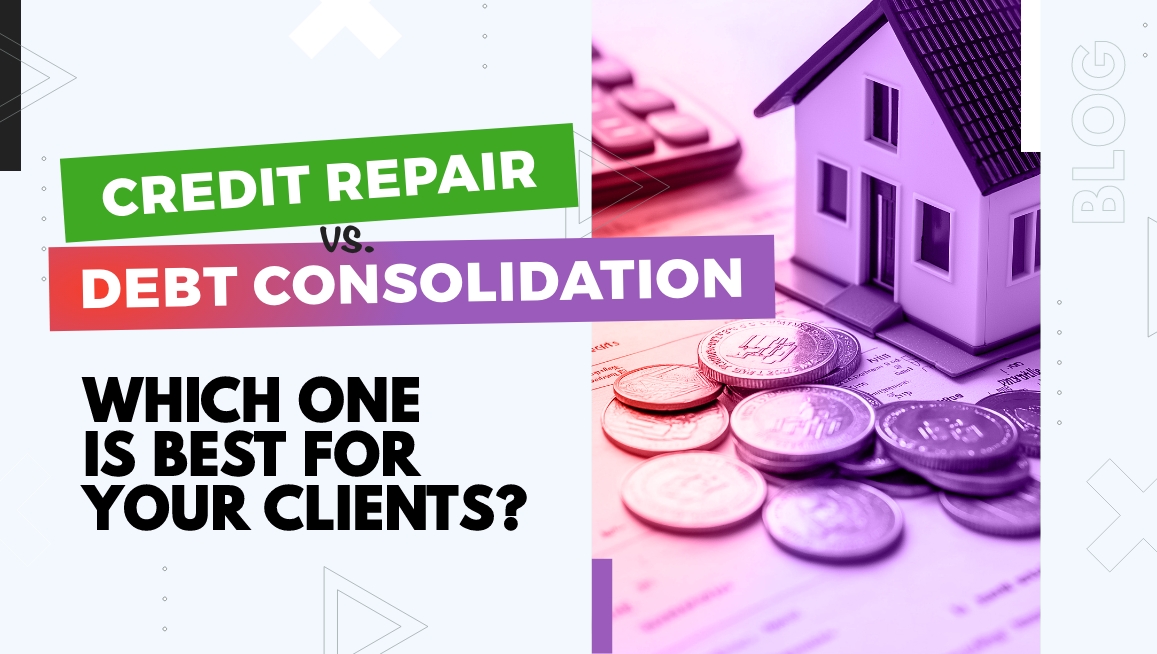Credit Repair vs. Debt Consolidation: Which One is Best for Your Clients?
by Almas Tariq
April 25, 2025
03:21 PM

When clients first approach your credit repair business, they often confuse credit repair vs debt consolidation, assuming they’re interchangeable solutions for financial distress. But as a credit repair professional, you know these two services serve entirely different purposes. Credit repair focuses on correcting inaccuracies in a credit report, improving credit scores, and educating clients about their financial profile. Debt consolidation, on the other hand, aims to simplify repayment by combining multiple debts into a single, more manageable loan. Unfortunately, this lack of understanding leads many clients to pursue the wrong solution—sometimes worsening their credit situation or delaying real progress.
As a credit repair business, your responsibility isn’t just offering dispute services—it’s providing clarity, education, and compliant guidance tailored to each client’s financial reality. This blog is designed to equip you with the insights needed to confidently explain the differences between credit repair and debt consolidation, assess which option aligns best with your clients’ goals, and avoid compliance pitfalls that can arise from miscommunication. With a firm grasp of both approaches, you can position yourself as a trusted advisor, empower your clients with accurate financial knowledge, and ensure your services are aligned with the laws that govern the credit repair industry.
Understanding Credit Repair – More Than Disputes
When discussing credit repair vs debt consolidation, it’s essential to understand that credit repair is not a quick fix. It is a regulated process designed to help clients challenge inaccurate or outdated information on their credit reports. Governed by the Credit Repair Organizations Act (CROA), credit repair services must follow strict compliance standards to protect consumers from misleading or harmful practices. As a credit repair business, understanding these rules is not optional—it is the foundation of your service model.
Under CROA, credit repair companies cannot charge fees before services are completed. They must also provide a written contract, include a three-day cancellation notice, and avoid any false promises or guarantees. These laws are in place to ensure clients are treated fairly and receive honest, lawful assistance. When credit repair businesses operate within this framework, they become trusted partners in their clients’ financial journey rather than just service providers.
At the core of credit repair is the process of disputing inaccurate or unverifiable information with credit bureaus and furnishers. This includes sending dispute letters, verifying account details, and ensuring the client’s credit report reflects accurate and current information. However, credit repair is not limited to disputes. It also includes validating debts, which ensures a debt is legitimate and legally collectible. If a debt cannot be validated, it may be removed from the credit report—an action that can directly improve a client’s credit standing.
Credit repair professionals also serve an important educational role. Most clients are unaware of how credit scores work or how certain behaviors impact their credit. Explaining concepts like credit utilization, payment history, and inquiry limits gives clients the tools they need to make smarter decisions. This level of support is what separates a transactional service from a transformational one.
As part of your work, you’ll address many types of negative items, including:
- Late payments
- Charge-offs
- Collections
- Bankruptcies
- Repossessions
- Foreclosures
- Incorrect personal information
Each of these items can be disputed if they are inaccurate, outdated, or unverifiable. However, credit repair professionals must never attempt to remove accurate, timely, and verifiable information, as this would violate CROA and other consumer protection laws.
That’s why education is not just helpful—it’s essential. Teaching your clients about their rights, the dispute process, and long-term credit behavior sets realistic expectations. It also empowers them to participate actively in their financial recovery. When clients understand how credit repair vs debt consolidation differs, they are less likely to fall for predatory services or make uninformed decisions.
As we move forward, it’s equally important to understand what debt consolidation is and why clients might think it’s a substitute for credit repair—when in reality, it serves a very different purpose.
What Debt Consolidation Actually Does
To clearly understand credit repair vs debt consolidation, credit repair professionals must grasp how debt consolidation works. While both strategies are often confused, their purposes and mechanisms are quite different. Credit repair focuses on correcting inaccurate information on a credit report, whereas debt consolidation is about managing and repaying debt more efficiently.
Debt consolidation involves combining multiple debts—usually high-interest credit card balances, medical bills, or personal loans—into a single, consolidated account. The goal is to simplify repayment, often with a fixed monthly payment, a lower interest rate, or both. It is a financial restructuring process, not a dispute resolution service.
There are several common forms of debt consolidation:
- Debt Consolidation Loans
Clients take out a new loan to pay off multiple existing debts. They now owe one lender, ideally at a lower interest rate. - Balance Transfer Credit Cards
Clients transfer multiple credit card balances onto one card offering a low or zero percent interest rate for a promotional period. - Nonprofit Debt Management Plans (DMPs)
These are structured repayment plans offered by nonprofit credit counseling agencies, allowing clients to pay off unsecured debt over time with negotiated terms.
Debt Consolidation Is About Repayment, Not Report Accuracy
Although debt consolidation may improve a client’s credit score over time, it does not address the accuracy or legality of information on the credit report. Any improvement in score typically results from reduced credit utilization, consistent payments, or closing high-interest accounts—not dispute activity or removals.
It is also important to educate clients about the potential risks involved in consolidation. These may include:
- Higher total interest paid if the term is extended
- Temporary drop in credit score due to new inquiries or account changes
- Exposure to scams, especially from non-accredited debt relief firms
Debt consolidation typically benefits clients who:
- Have multiple debts with varying interest rates
- Can afford regular monthly payments but need better structure
- Want a simplified way to manage outstanding obligations
As a credit repair business, it is essential to not present debt consolidation as a credit repair solution. While both strategies can improve financial health, they do so through entirely different means. Making this distinction clear helps clients make informed decisions and protects your business from compliance risks.
Next, we’ll take a deeper look at how credit repair vs debt consolidation compares when analyzed side by side.
Credit Repair vs Debt Consolidation – A Functional Breakdown
To serve your clients effectively, you must be able to explain credit repair vs debt consolidation in a clear and factual way. While both aim to improve financial health, they work through very different mechanisms and serve different client needs. Credit repair focuses on correcting credit report errors, while debt consolidation restructures how a client repays debt.
Use this side-by-side breakdown to guide your client conversations:
| Category | Credit Repair | Debt Consolidation |
| Purpose | To dispute and correct inaccurate credit report items | To combine multiple debts into one manageable loan or payment plan |
| Target Audience | Clients with errors, outdated data, or unverifiable accounts | Clients with high debt balances or multiple payments causing financial strain |
| Legal Protections | Governed by the Credit Repair Organizations Act (CROA) | Regulated by lending laws and state consumer protection regulations |
| Process | Review credit reports, send disputes, validate debts, and track changes | Apply for consolidation, pay off old debts, repay under new structure |
| Timeframe | Typically 3–6 months to see measurable credit score improvement | Ongoing—depends on loan term or repayment plan |
| Cost | Pay-per-delete, monthly plans, or flat fees; no upfront charges allowed (CROA) | Loan interest, fees, or service charges depending on provider |
| Credit Impact | Potential to increase score by removing inaccurate negative items | May improve score over time through lower utilization and on-time payments |
By understanding these core differences, credit repair professionals can ensure clients pursue the right path—while staying compliant and focused on real solutions. Next, we’ll explore how to assess what your client truly needs.
Guiding Clients: How to Know What They Actually Need
Choosing between credit repair vs debt consolidation is not always straightforward. Many clients are unsure of their actual financial challenges, and even fewer understand the impact each option can have. As a credit repair professional, your role includes identifying the client’s needs before recommending a service. By asking the right questions and assessing key indicators, you can guide clients toward the right solution—while staying compliant and building trust.
Begin every client evaluation by asking these essential questions:
-
Are the reported debts accurate or erroneous?
If the credit report contains incorrect balances, outdated accounts, or accounts that don’t belong to the client, credit repair is the right starting point.
-
Is the main goal to improve credit score or to manage payments?
Clients who want to raise their score to qualify for a loan may need credit repair. Those struggling to keep up with multiple payments might benefit more from debt consolidation.
-
Is the client overwhelmed with collections or just disorganized with payments?
If the client is confused by multiple due dates but not disputing the legitimacy of debts, consolidation could offer relief. However, if they question the accuracy of these collections, credit repair should come first.
To simplify your evaluation process, use this quick eligibility checklist:
- ✅ Inaccurate or unverifiable items on credit reports → Credit Repair
- ✅ Multiple valid debts with high interest → Debt Consolidation
- ✅ Desire to improve credit score → Start with Credit Repair
- ✅ Trouble managing multiple due dates → Consider Consolidation Support
In some cases, the client may benefit from both services. If a client has accurate but unmanageable debt, and also a few errors on their credit report, you can start with credit repair while also referring them to a licensed debt consolidation partner. However, ensure this referral is made in compliance with CROA and includes proper disclosures. Never market consolidation as part of your credit repair service unless you are legally authorized to offer both.
Helping clients understand credit repair vs debt consolidation begins with understanding their pain points. By taking a personalized, question-driven approach, you position your business as a trusted advisor—not just a service provider.
Next, we’ll explore when and how both solutions can be used together to help clients achieve stronger, lasting results.
Can Credit Repair and Debt Consolidation Work Together?
In many cases, your clients may need more than one solution. When comparing credit repair vs debt consolidation, it’s easy to view them as separate paths. However, some clients benefit from a combined approach—if it’s done strategically and in full compliance with the law.
Consider a client who has several high-interest credit card balances and also a credit report filled with outdated or inaccurate negative items. If they consolidate their valid debts into one monthly payment, they reduce financial pressure. At the same time, if those negative entries are erroneous, credit repair can help improve their score while they manage repayment.
The timeline of combining both services matters. Often, credit repair should begin before or alongside debt consolidation. By correcting errors first, clients can potentially raise their credit scores. This could qualify them for better consolidation loan terms with lower interest rates.
That said, not all cases are the same. Some clients may complete debt consolidation before seeking credit repair support. This is still effective as long as credit repair addresses errors—not valid, verified debt. Your guidance will determine how successful the combined approach is.
If you refer clients to a debt consolidation company, stay compliant with the Credit Repair Organizations Act (CROA) and FTC guidelines. Always disclose that debt consolidation is a separate service and ensure that the referral partner is properly licensed and legitimate. Never market consolidation services under your credit repair umbrella unless your business is licensed for both.
When applied carefully, credit repair and debt consolidation can support each other. Just be sure your approach is individualized, legally sound, and transparent at every stage. In the next section, we’ll explore why compliance isn’t just a legal requirement—it’s a strategic advantage.
Why Credit Repair Education Is the Real Differentiator
When comparing credit repair vs debt consolidation, many clients wrongly assume that both solve the same problem. Most people think if they are in debt, their credit must be bad—and that any solution labeled “credit” will fix it. As a credit repair professional, you must correct this misconception through consistent client education.
Your role goes beyond disputes and deletions. You are also a financial educator. Clients need to understand that not all debts hurt credit, and not all negative marks are errors. By teaching them how credit scores are calculated and what actions influence their profile, you help them take ownership of their financial future.
Education Builds Trust, Results, and Long-Term Client Success
Credit repair education also helps clients avoid scams and false promises. When clients understand what credit repair vs debt consolidation actually mean, they’re less likely to fall for illegal or misleading services. You give them confidence, clarity, and control over their next steps.
There are several tools and strategies you can use to deliver that education effectively:
- Onboarding Flows: Teach clients from day one how your process works and what they can expect.
- Email Newsletters: Share tips, score-building habits, and updates about credit law changes.
- Webinars and Workshops: Host live or recorded sessions on credit reports, disputes, or financial planning.
Educated clients make better decisions. They also stay longer, engage more, and refer others. That’s why education is not just a value-add—it’s a business strategy. It differentiates you from competitors, builds compliance, and strengthens your client relationships.
Now that you’ve seen the power of education, let’s focus on how to stay compliant while delivering credit repair services that truly make a difference.
Conclusion: The Right Guidance Begins with Understanding
In the conversation around credit repair vs debt consolidation, it’s clear that these two strategies serve very different purposes. Credit repair helps remove inaccurate, outdated, or unverifiable items from a client’s credit report. Debt consolidation, on the other hand, restructures how a client repays legitimate debt. While they both support financial improvement, they do so through distinct methods and timelines.
As a credit repair professional, your role is not to offer one-size-fits-all solutions. Your job is to evaluate, educate, and guide your clients based on their unique financial challenges. That means understanding the full scope of their credit history, identifying which solution fits their situation, and knowing when both credit repair and debt consolidation may be appropriate—always with transparency and full compliance.
Clients trust you not just because you send disputes, but because you help them make sense of their credit. That trust is earned by following the rules set out in the Credit Repair Organizations Act (CROA), avoiding misleading claims, and offering real solutions based on facts—not assumptions. Compliance is not a barrier—it’s your biggest credibility builder.
- As you continue to grow your credit repair business, take time to assess your current processes.
- Are you consistently educating clients?
- Are your partnerships and referrals compliant?
- Are your tools helping you stay efficient and transparent?
If you’re ready to scale your credit repair business while staying compliant and client-focused, consider using ScoreCEO. It’s a credit repair software designed specifically for businesses like yours. With automated workflows, compliance tools, client education portals, and CRM features built in, ScoreCEO helps you focus on what matters—results.
FAQ’s
Q: Is it better to do debt consolidation or debt relief?
A: Debt consolidation combines debts into one manageable payment, while debt relief may reduce what you owe. The better option depends on your financial situation and ability to repay.
Q: What is the difference between credit repair and debt relief?
A: Credit repair focuses on fixing errors on credit reports to improve credit scores. Debt relief works to reduce or settle the total debt owed.
Q: What is the difference between debt consolidation and credit counselling?
A: Debt consolidation restructures payments into one loan. Credit counselling offers budgeting support and creates a plan to manage debts, often without new loans.
References:
Table of Contents
Explore More Insights
Dive deeper into a wealth of knowledge. Discover a multitude of articles covering diverse topics, expert perspectives, and the latest trends. Feed your curiosity and expand your understanding.




